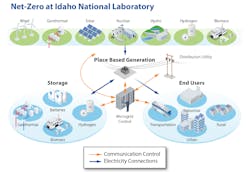A nuclear microgrid? National lab sets out to test the idea
Microgrids use many kinds of energy, typically renewables, natural gas, diesel, fuel cells, batteries or combined heat and power. But we’ve yet to see a nuclear microgrid. Now the US’ top nuclear energy lab wants to change that.
Idaho National Laboratory (INL), a Department of Energy (DOE) research facility, intends to build a prototype nuclear microgrid at its campus in Idaho Falls.
The lab’s nuclear microgrid would be part of a larger effort to achieve net-zero carbon emissions for the facility by 2031.
“Nuclear energy is absolutely essential to achieving national and international net-zero goals,” said John Wagner, INL director. “We see this work as not only a core part of our mission, but also an opportunity to lead by example and reduce barriers to deploying emission-free nuclear energy technologies to local and global communities.”
Battelle Energy Alliance, which operates the INL facility, has issued a request for information (RFI) seeking industry input on the concept.
“We are reaching out to our various stakeholders, including utilities, industry developers and energy users in order to integrate knowledge and perspectives that will improve our final product,” said Jhansi Kandasamy, net-zero program director at the lab.
The lab wants to create a national model to show that it’s possible for conventional technologies to work “in tandem with cutting-edge clean energy technologies,” according to the RFI.
Advanced modular and micronuclear reactors, as well as other energy resources, would produce electricity, thermal energy, hydrogen, ammonia and other products that may help INL achieve its net-zero goals.
The project comes as nuclear proponents try to rekindle support for the technology after its decline in the US. Nuclear power reached its height in 2012 with 104 nuclear reactors providing about 102,000 MW. That number had dropped at the end of 2021 to 93 reactors generating 95,492 MW, according to the US Energy Information Administration.
Interested in microgrids? Philadelphia is the place to be on June 1-2 at Microgrid 2022: Microgrids as Climate Heroes, the largest worldwide gathering of microgrid leaders, thinkers and innovators.
Supporters of the technology are proposing smaller designs they hope will bring new life to the industry. Preassembled in a factory to reduce costs, the microreactors could be transported by truck, train, plane or ship and would be able to operate in a more flexible manner than large nuclear plants. The DOE describes the designs as “self-adjusting,” meaning they would not require a large number of specialized operators and would use passive safety systems to prevent reactor meltdown.
In justifying the nuclear microgrid, the RFI describes several peer-reviewed studies that indicate nuclear power could play a significant role in carbon reduction. It also points to France, which decarbonized its grid 80% in less than two decades by scaling up nuclear power.
Idaho campus suited for microgrids
The INL campus provides “convenient opportunities” to demonstrate microgrids of 5 MW to 15 MW, according to the RFI. About 890 square miles, the campus is “like a small city with more than 100 miles of transmission lines, a landfill, a vehicle fleet, numerous buildings and hundreds of miles of roads — all emission sources that need to be addressed.”
While local utility Idaho Power now provides the campus’ power — about 190,000 MWh annually — INL is not precluded contractually from generating its own power. However, third parties cannot interconnect on the campus without the utility’s permission. And the on-site power system cannot generate more electricity than the campus needs and then export it directly to the bulk electric system. Instead, a utility corridor would need to be built that would connect to a switching station on the bulk power system. So generation owners may have to partner with the utility to participate in the microgrid.
The project would be built in three parts: demonstration, pilot applications and campuswide application. Batelle is not seeking contractors or suppliers at this time but anticipates doing so at a future date, bringing together manufacturers, pipelines and fuel transporters, clean fuels suppliers, researchers and utilities.
Responses to the RFI must be submitted, in writing, to [email protected] by 5 p.m. MST May 16.
Track news about microgrid innovation. Subscribe to the free Microgrid Knowledge Newsletter.
About the Author
Elisa Wood
Editor-in-Chief
Elisa Wood is the editor and founder of EnergyChangemakers.com. She is co-founder and former editor of Microgrid Knowledge.
